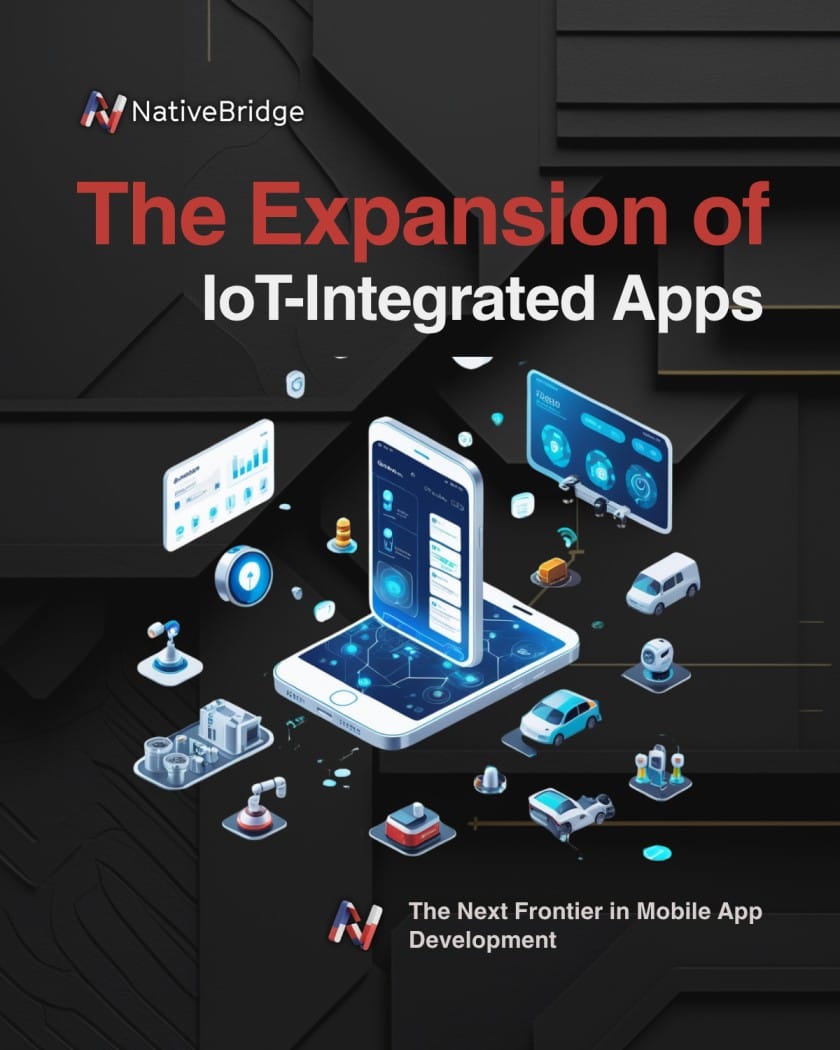The Expansion of IoT-Integrated Apps: The Next Frontier in Mobile App Development

The rise of smart devices has radically transformed how we interact with technology. At the heart of this transformation is the Internet of Things (IoT), which connects everyday devices to the internet, allowing for intelligent communication and automation. With over 14 billion IoT devices in use globally as of 2024, mobile app development is experiencing a major shift as developers increasingly build applications that harness the power of IoT.
As we head deeper into 2025, the expansion of IoT-integrated mobile apps is emerging as one of the most impactful trends in the tech ecosystem. Whether it's smart home systems, healthcare monitors, or industrial automation, mobile apps are the glue binding the IoT network. This blog explores why IoT-integrated apps are booming, the benefits they offer, the challenges they bring, and how platforms like NativeBridge.io are helping developers stay ahead in this evolving space.
Why IoT Integration in Mobile Apps Is Growing
- Surging Demand for Smart Living: Consumers today are more connected than ever. Smart homes, wearable devices, and voice-controlled assistants are no longer futuristic novelties-they’re daily essentials. This rising demand pushes developers to create mobile apps that sync effortlessly with IoT devices, enabling centralized control and seamless user experiences.
- Enterprise Adoption of IoT: Businesses are investing heavily in IoT for logistics, supply chain optimization, inventory tracking, and predictive maintenance. Mobile apps serve as the user interface to monitor and control these systems in real-time.
- Growth in Edge Computing: With the advent of edge computing, data is processed closer to where it is generated-on the IoT device or nearby. This reduces latency and opens up more use cases for real-time mobile apps, particularly in industries like healthcare, manufacturing, and autonomous vehicles.
Key Benefits of IoT-Integrated Mobile Apps
- Personalization & Automation: By tapping into data from multiple IoT devices, mobile apps can personalize experiences for users and automate tasks-like adjusting the thermostat or scheduling a morning alarm based on activity levels.
- Real-Time Analytics: Apps connected to IoT devices can analyze incoming data streams to make split-second decisions, ideal for monitoring health vitals or ensuring safety in industrial settings.
- Improved Efficiency: IoT apps streamline operations by automating repetitive tasks. For example, agriculture apps can connect to soil sensors to automate irrigation, saving both time and resources.
- Scalability: When built right, IoT-integrated apps can easily scale across devices and locations. Tools like NativeBridge.io offer developers CI/CD pipelines tailored for mobile apps, enabling them to push updates and improvements across large device fleets efficiently.
Top Use Cases in 2025
- Healthcare: Wearables like smartwatches and glucose monitors are becoming more sophisticated. Mobile apps act as personal health dashboards, providing real-time alerts, health summaries, and emergency integrations.
- Smart Cities: Traffic sensors, waste management systems, and public safety alerts are all driven by IoT. Citizens use mobile apps to interact with these systems in real time.
- Industrial IoT (IIoT): Manufacturing floors use mobile apps connected to sensors and machinery to monitor uptime, detect faults, and manage workflow.
- Retail & Logistics: From smart shelves to temperature-controlled supply chains, retail apps connected to IoT enable real-time inventory management and predictive stock replenishment.
- Home Automation: Thermostats, smart lights, and security systems are now managed from centralized mobile apps, integrating devices into a single, cohesive control center.
Challenges in IoT App Development
- Security Concerns: IoT devices often become easy entry points for cyberattacks. Developers must integrate end-to-end encryption and frequent updates. NativeBridge.io supports secure OTA (over-the-air) updates to keep apps and connected devices protected.
- Platform Fragmentation: IoT involves a mix of operating systems, communication protocols, and hardware specs. Ensuring compatibility across all devices is a monumental task.
- Data Overload: With a massive volume of data streaming from devices, apps must be optimized to filter and analyze relevant data efficiently. Leveraging AI within mobile apps helps manage and make sense of this data.
- Latency and Reliability: Time-sensitive applications, especially in healthcare and manufacturing, cannot tolerate delays. Edge computing helps, but developers need robust deployment platforms-like NativeBridge.io-to keep latency low and performance high.
How NativeBridge.io Supports IoT Mobile Development
As more developers dive into IoT-integrated app development, the need for streamlined build, testing, and deployment workflows becomes critical. NativeBridge.io steps in here as a modern alternative to App Center, purpose-built for mobile developers.
- Fast CI/CD Pipelines: NativeBridge.io offers lightning-fast build pipelines for Flutter, React Native, and native apps. This is vital when rolling out frequent updates across hundreds of device types.
- Over-the-Air (OTA) Updates: IoT apps often run in environments where manual updates aren't practical. NativeBridge.io supports secure and seamless OTA updates to keep apps current without user intervention.
- Multi-Platform Support: Whether you're targeting iOS, Android, or both, NativeBridge.io ensures that your app integrates smoothly with a range of device ecosystems.
- Security-Focused Architecture: Built with security in mind, NativeBridge.io helps protect against vulnerabilities common in IoT environments, offering end-to-end encryption and compliance features.
What’s Next for IoT and Mobile Apps?
Looking ahead, the intersection of IoT and mobile development is only going to deepen. The integration of AI and machine learning will empower apps to predict user needs, automate device coordination, and even make decisions independently. Meanwhile, advances in 5G and edge computing will further enhance real-time responsiveness.
For developers, the challenge is to keep up with the pace of innovation while ensuring scalability, reliability, and security. Leveraging modern platforms like NativeBridge.io can make the difference between a struggling app and a standout one.
As mobile apps evolve from simple utilities to intelligent hubs of connected ecosystems, one thing is clear: IoT integration isn’t just a trend- it’s the future.
